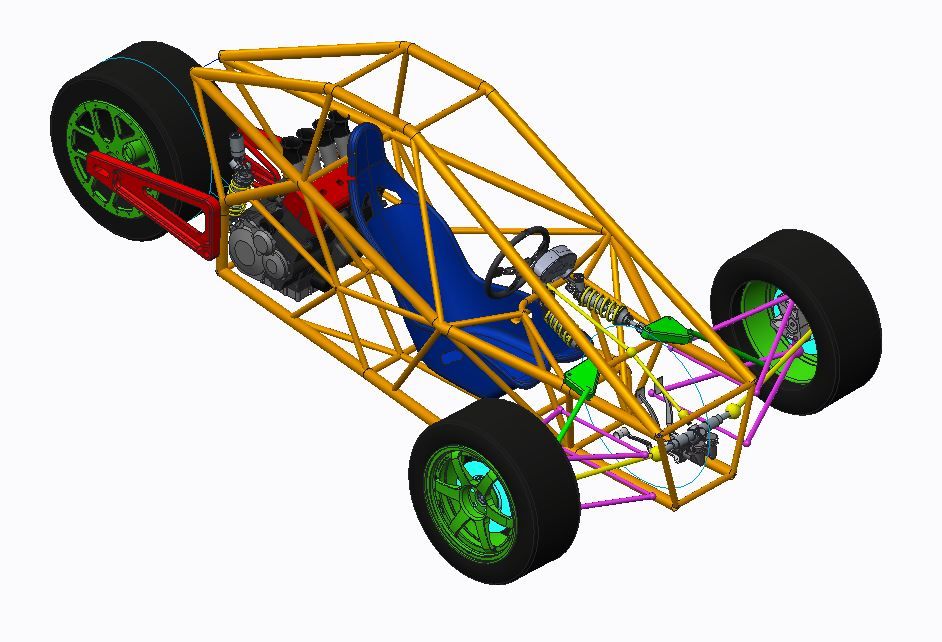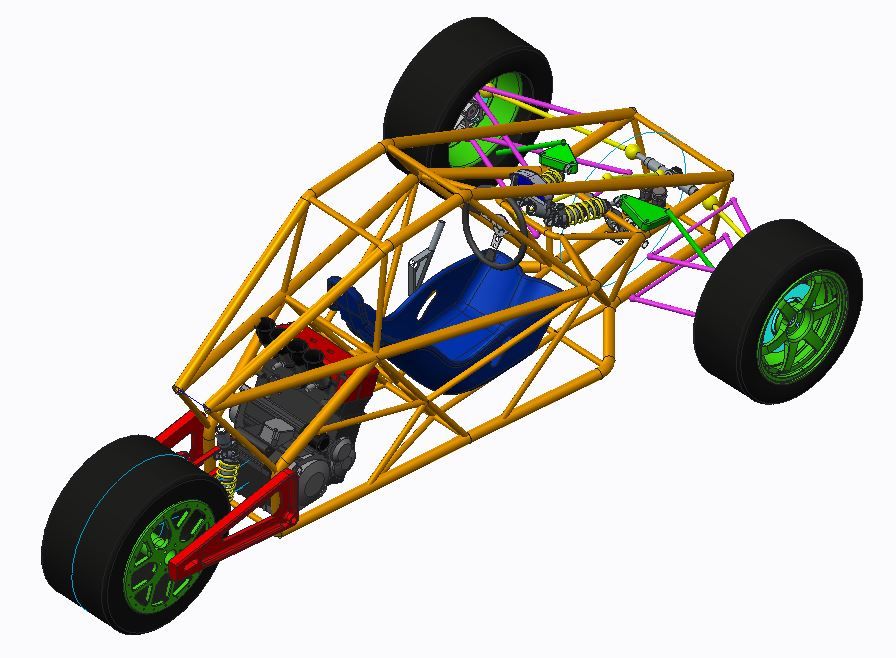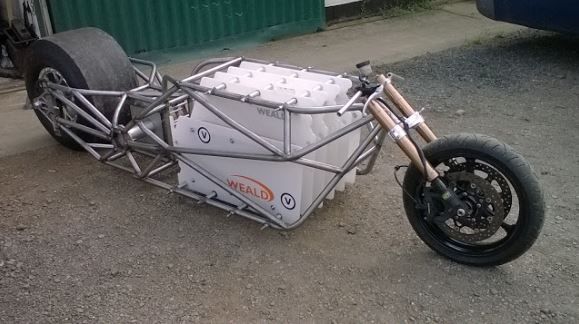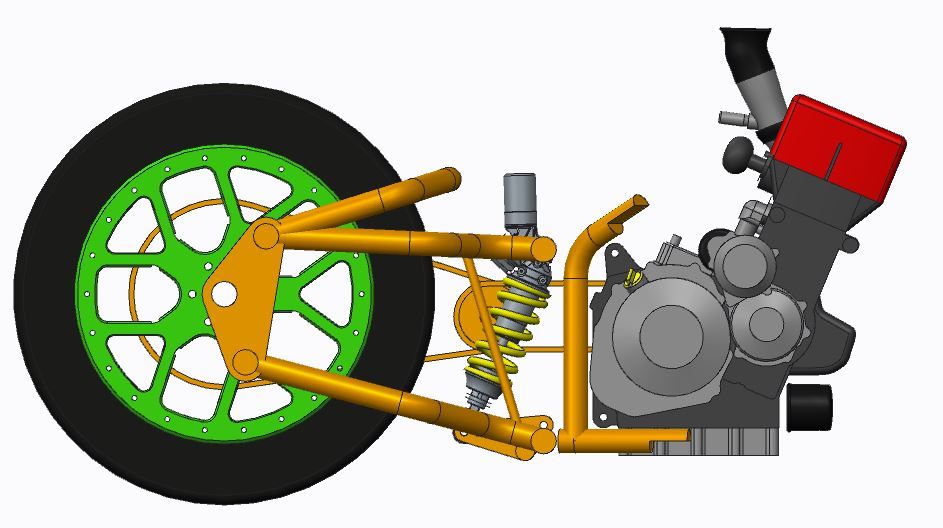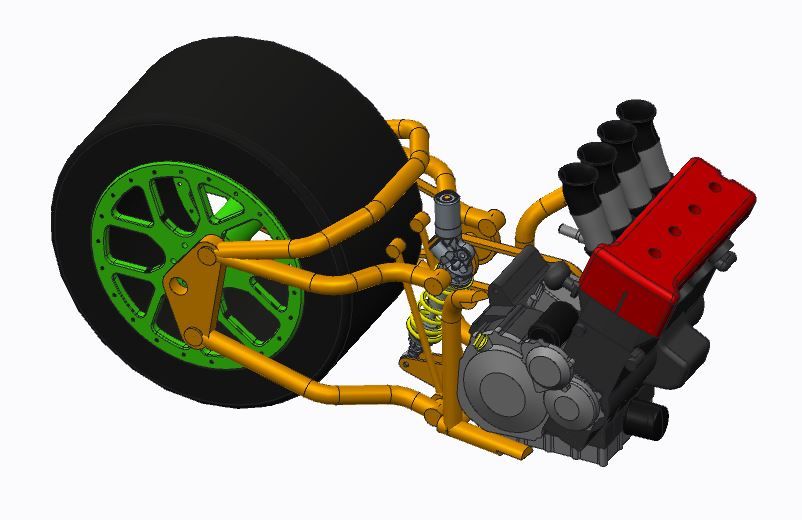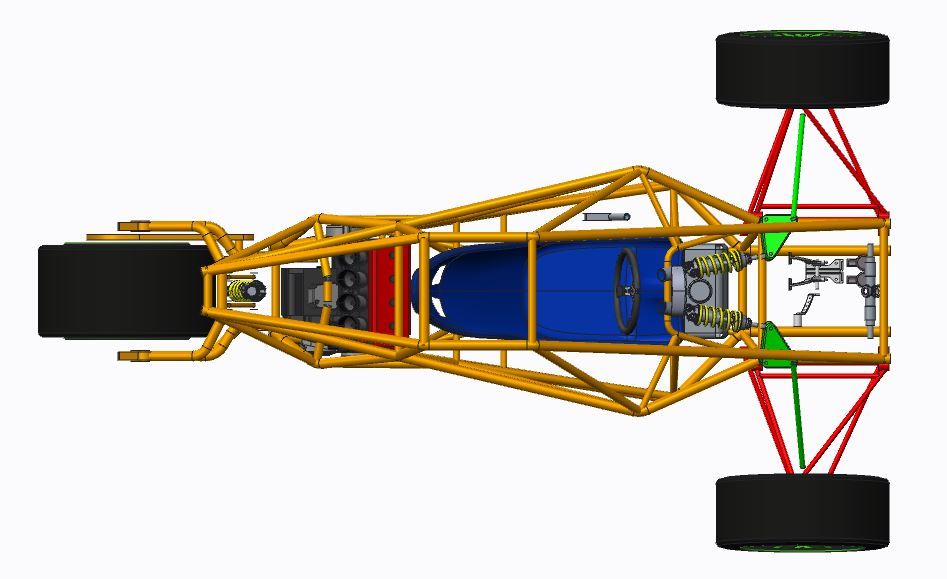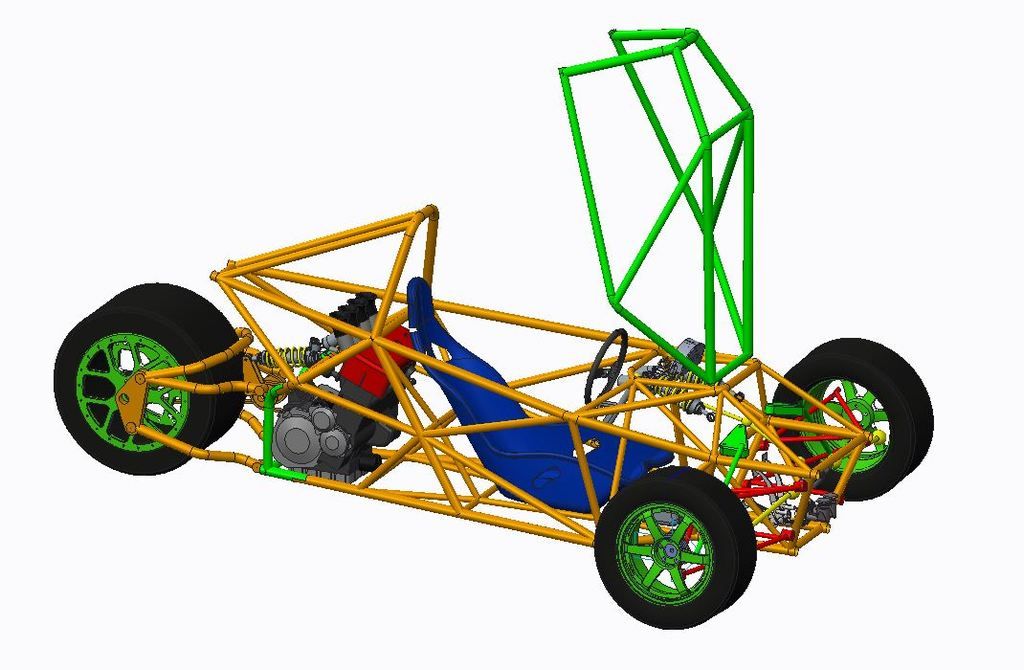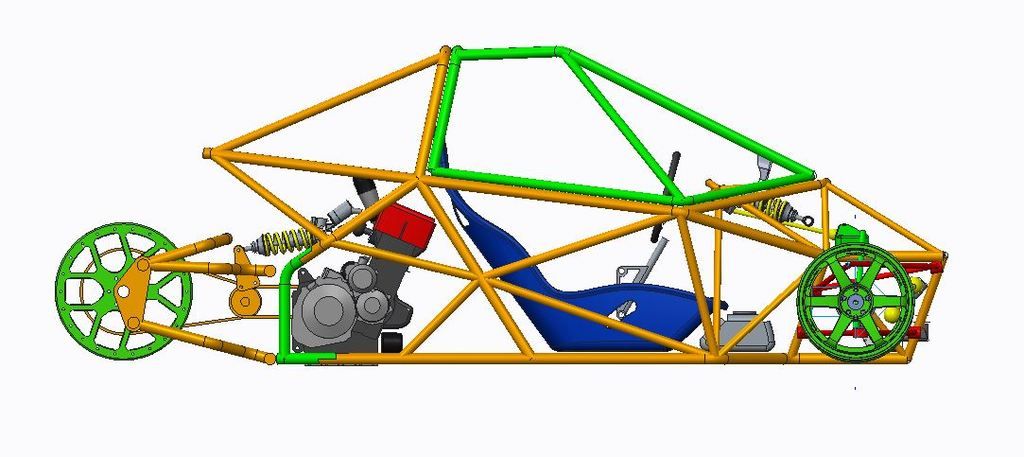Post by eclipse on May 12, 2018 6:16:27 GMT -5
Hi all – apologies for a rather long-winded post, but hopefully it will be worth it!
So after several months, or possibly even years, of debating the merits and shortfalls of a friend’s spaceframed Mk1 Polo design, I finally tipped over the edge and started compiling all of I disagreeorted thoughts and sketches into a design of my own, which I one day hope to engineer into my own vehicle.
The project, currently referred to as ‘Darkside’, aims to bring together the most exciting engineering elements of a prototype race car design; with a high-revving motorcycle powertrain in an ultralight chassis that makes the best of both worlds.
It’s very early days, of course (the basic layout is changing every time I look at it!), but the initial project brief is to create something which is minimalistic, lightweight and ultra high performance, with an immersive driving experience that is second-to-none. It’s also got to be cost-effective and scaleable in terms of manufacturing and performance.
The motivation behind the project lies primarily with the engineering journey. Whilst I’ve had my fair share of experience riding & racing fast bikes, I have never built nor driven a high performance car, nor do I profess to be any kind of skilled driver. As a motorcyclist I find the engagement of a bike to be completely unparalleled, however as an engineer I must admit to having a distinct level of lust whenever I am in the presence of a true race car; and in the context of the latter, it’s the ability to so directly influence the performance of the vehicle through engineering design that fascinates me most (a trait that, generally speaking, the motorcycle world is somewhat lacking in).
So, the high-level design philosophy needs to be:
1. Uncompromising high performance and light weight.
2. An exhilarating experience, both to drive and to look at.
3. Provide scope for exploring some really interesting design and manufacturing challenges.
The summation of these thoughts has lead me towards this project; a motorcycle-engined reverse trike unlike any other.
The production benchmarks that I’ve come across in my limited travels include the Campagna T-Rex, the Tanom Invader and the Scorpion P6, however whilst these undoubtedly look like fun, to me they just don’t do it properly. Now, I appreciate that ‘it’ is of course entirely subjective, but when I look at them I see technical oversights and styling-driven compromises that surely detriment performance, and which are therefore, in the context of my project, unacceptable.
So what am I planning to do differently?
Up front, I plan for the vehicle to have geometry similar to that of a single-seater racing car, with compact double-wishbone pushrod suspension and many of the main components that one would expect to see on a capable hill climb or sprint car.
The chassis itself will be of tubular steel construction, and highly optimised for the task in hand. A single occupant will be positioned low in the vehicle, with the cockpit and controls again similar to that of a racing car, only with a rollover protection structure integrated in to the basic spaceframe.
At the rear, behind the driver’s seat, will be the motorcycle-derived powertrain. The exact motor selection is, as with many things, yet to be confirmed, but it’s highly likely to be the venerable Suzuki Hayabusa engine so popular with ultralight vehicle manufacturers the world over. The big Suzuki benefits from a well-proven and robust design, with a plentiful supply of race-proven parts and upgrades available to help improve durability and performance above the already lofty ~180bhp that it can achieve in its standard configuration.
As an initial guess, I would say that it makes sense to develop the chassis around a stock and naturally-aspirated motor, with package protection for a considerable power-up at a latter phase of the project (who could say no to a ~350bhp supercharged ‘Busa with anti-lag, methanol injection and air shifting?). The only notable changes that I see as necessary up front will be to convert to a dry-sump oil system such as that offered by SBD (to leverage the mass distribution advantages of negating the tall motorcycle sump), and potentially an upgrade to some of the internal clutch and transmission components in preparation for a sizable increase in duty cycle, by virtue of having to lug around a comparably greater mass than that of Suzuki’s original design intent (initial calcs suggest that the A-ratio option from Nova will do nicely).
At a high level, the advantages of choosing a motorcycle-derived engine over a high-performance car engine are pretty well understood; unrivalled power- and package density in a cost effective and COTS solution that anyone can buy. Combine that with a lateral output shaft orientation, an integrated six-speed sequential transmission and the ability to easily configure clutchless upshifting and downshifting, and the net result is perfect for ultralight vehicles seeking a near ‘plug-and-play’ powertrain/transmission combination.
So finally, the use of a single rear wheel. This decision alone will undoubtedly set this design apart from most other home-build specials, and achieving the best handling performance whilst driving through only one wheel poses some very interesting engineering problems to solve. I’m keen to explore a wider-than-average tyre and so a bespoke swinging arm will be required, alongside a unique suspension system and potentially a layshaft to achieve the desired squat characteristics.
The geometry that defines these parts, as well as their interaction with the final drive chain and sprocket combination, will need to evolve simultaneously as I believe that it will have such a large impact on the tractive capability of the finished product, so naturally this is an area of the design which I am very much looking forward to sinking my teeth in to!
In terms of aerodynamics and bodywork, I honestly haven’t thought that far ahead. I’m certainly not experienced in either of these two areas, so this will inevitably be a bridge that we will need to cross when the time is right, and the design more mature. One thing’s for sure – I want to steer well clear of the ‘mid life crisis’ look that some of the productionised reverse trikes seem to have nailed (and if I’m honest, I thought Cody Loveland’s Enviate hypercar looked better without it’s clothes on anyway!).
Regarding the layout, there appears to be several advantages to me in the selection of a reverse trike configuration; but primarily it boils down to cost, weight and complexity. By using only a single driven wheel we remove the need for an expensive differential unit/housing, independent rear suspension and rear roll control system. We also benefit from a much smaller bill for running gear such as driveshafts, knuckles, CV joints and suspension system components (all of which will require considerable engineering effort!), all the while making the vehicle lighter. We can also make use of a motorcycle-style chain and sprocket final drive, which benefits from very low cost, very low inertia and the ability to easily tune the vehicle’s acceleration characteristics – perfect!
Obviously the major drawback will be a comparative lack of tyre contract area, and thus traction, which will undoubtedly be a key driver in the fundamental architecture and chassis layout as we try to remain focussed on optimising whatever grip we are able to find; which becomes all the more important in the context of my quick British Cigarett-packet weight calc which suggests a ready-to-roll vehicle mass of ~360kg!
So, there we have it. In isolation, none of the top-level designs that I have on the table are particularly revolutionary, or even innovative. However, it’s the marriage of these elements into such a unique package, and supported by some (hopefully!) decent mechanical engineering, that makes this project really exciting to me. I’m certainly looking forward to the journey, and will be sure to update this thread as-and-when news becomes available.
The basic vehicle parameters, at this stage, are:
- Occupants: 1
- Wheelbase: TBC
- Track: TBC
- Ground clearance: TBC
- Powertrain: >1000cc motorcycle engine, N/A but with flexibility to look towards a forced induction solution in due course.
- Chassis: Tubular steel spaceframe with integrated rollover protection system
- Front Suspension: Independent pushrod-actuated, with potential to explore an ARB system if required, akin to a single-seater racing car
- Rear Suspension: Linkage-actuated double-sided swinging arm with monoshock, akin to a high performance motorcycle
- Transmission: Chain & sprocket, potentially with layshaft
- Electronics: OE motorcycle ECU (to accommodate quickshift, launch control etc functionality)
- Cockpit and controls: Akin to single-seater racing car
- Target kerb weight: <360kg
- Estimated project cost: ~£16k GBP (yeah… right!)
The design drivers, at this stage, will be:
- Engineering exceptional acceleration and performance.
- Optimising traction to realise genuinely exhilarating chassis performance.
- Keeping overall weight and assembly complexity to a minimum.
- Maintaining a low CoG-Z height.
- Package-protecting for further improvements in performance.
The biggest engineering challenges that I see are:
- Design of the rear suspension system, and it’s interaction with the final drive system.
- Tractive effort (transmission selection)
- Squat characteristics (suspension/transmission interaction)
- Wheel rate (linkage design & spec)
- Optimisation of the front suspension and steering hardpoint geometry.
- Roll centre (front suspension design)
- Wheel rate (linkage design & spec)
- Roll control system (ARB design & spec)
- Steering geometry
- Accommodating all of the requirements to have the vehicle UK road registered (for which I currently know virtually nothing of!)
Unfortunately for me I’m not blessed with many machining/fabrication facilities at home, so in the interests of making progress I’m having to accept that the project will likely lean more towards calculation, design & optimisation with parts produced by a network of suppliers, rather than being led by iterative manufacturing & home-brew prototyping loops - which is fine by me, especially if the design were ever to be replicated or sold on.
Nevertheless, I’m totally in at the deep end with this project so would be very interested to hear all constructive comments and feedback, good or bad!
The journey starts here…
wish me luck!
-Rob
NB: About me – I’m a mechanical design engineer based in Coventry, UK, and working in the motorcycle industry. Most of my experience lies in motorcycle chassis design & development projects, although I have had brief excursions into powertrain and project management work. I’ve a reasonable level of experience in practical mechanics & manufacturing, plenty of experience in riding & racing motorcycles, but practically zero knowledge of anything with more than two wheels, as you may be able to tell!
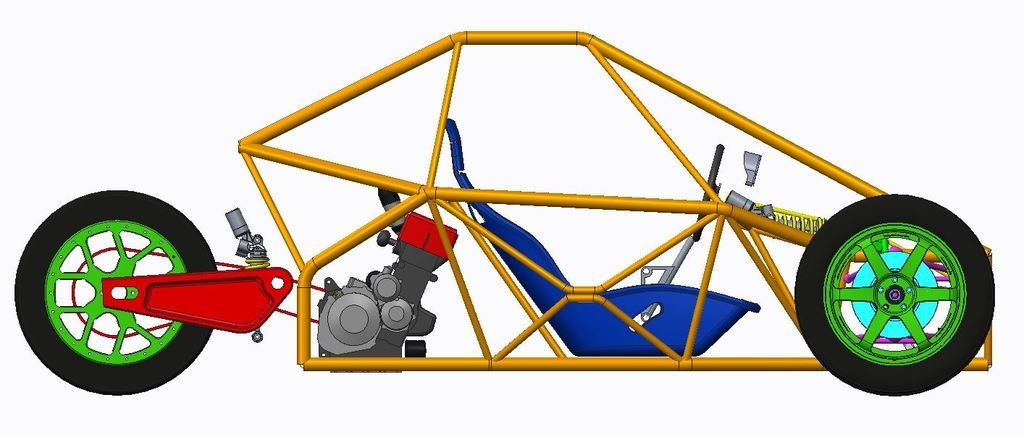
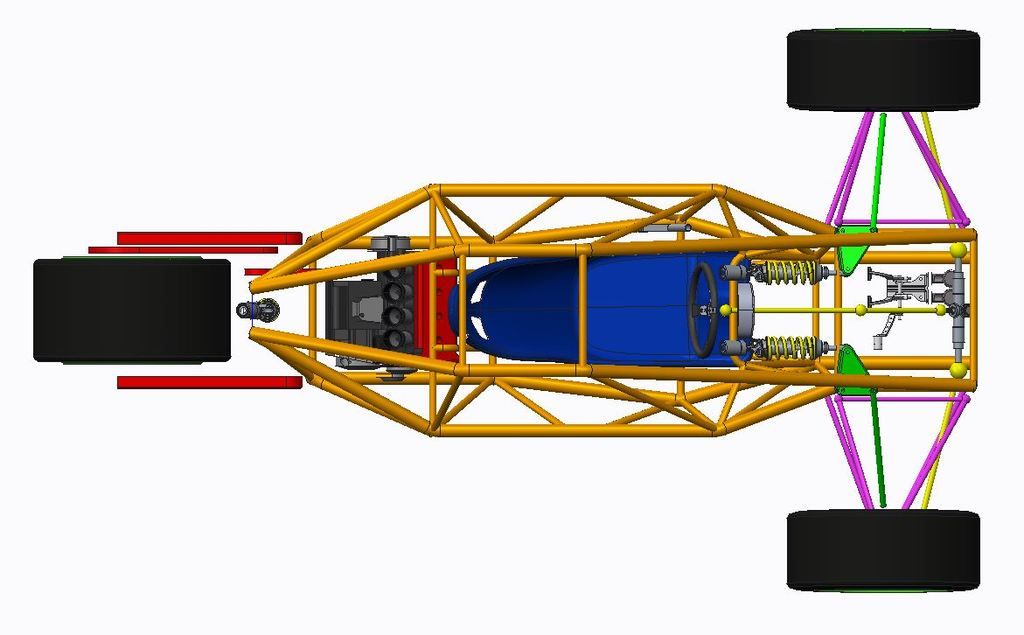


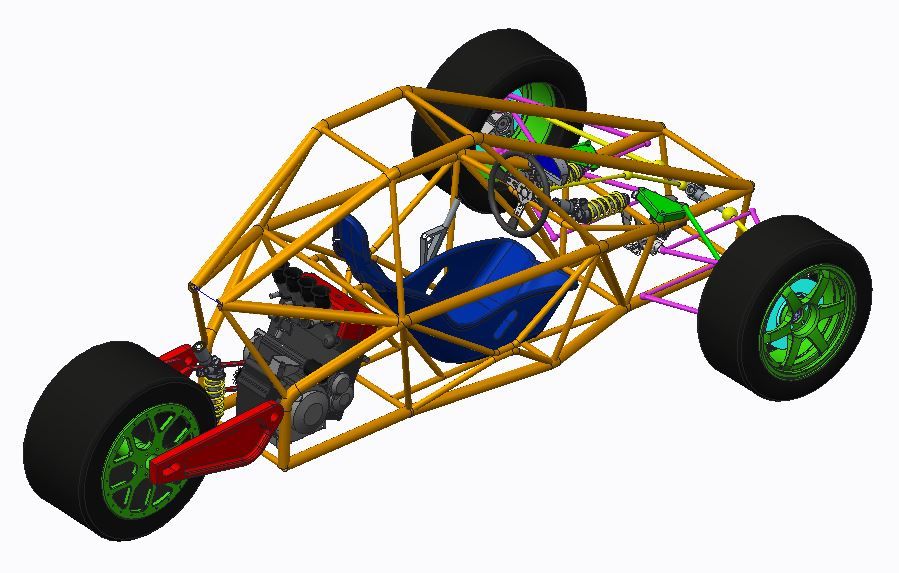
So after several months, or possibly even years, of debating the merits and shortfalls of a friend’s spaceframed Mk1 Polo design, I finally tipped over the edge and started compiling all of I disagreeorted thoughts and sketches into a design of my own, which I one day hope to engineer into my own vehicle.
The project, currently referred to as ‘Darkside’, aims to bring together the most exciting engineering elements of a prototype race car design; with a high-revving motorcycle powertrain in an ultralight chassis that makes the best of both worlds.
It’s very early days, of course (the basic layout is changing every time I look at it!), but the initial project brief is to create something which is minimalistic, lightweight and ultra high performance, with an immersive driving experience that is second-to-none. It’s also got to be cost-effective and scaleable in terms of manufacturing and performance.
The motivation behind the project lies primarily with the engineering journey. Whilst I’ve had my fair share of experience riding & racing fast bikes, I have never built nor driven a high performance car, nor do I profess to be any kind of skilled driver. As a motorcyclist I find the engagement of a bike to be completely unparalleled, however as an engineer I must admit to having a distinct level of lust whenever I am in the presence of a true race car; and in the context of the latter, it’s the ability to so directly influence the performance of the vehicle through engineering design that fascinates me most (a trait that, generally speaking, the motorcycle world is somewhat lacking in).
So, the high-level design philosophy needs to be:
1. Uncompromising high performance and light weight.
2. An exhilarating experience, both to drive and to look at.
3. Provide scope for exploring some really interesting design and manufacturing challenges.
The summation of these thoughts has lead me towards this project; a motorcycle-engined reverse trike unlike any other.
The production benchmarks that I’ve come across in my limited travels include the Campagna T-Rex, the Tanom Invader and the Scorpion P6, however whilst these undoubtedly look like fun, to me they just don’t do it properly. Now, I appreciate that ‘it’ is of course entirely subjective, but when I look at them I see technical oversights and styling-driven compromises that surely detriment performance, and which are therefore, in the context of my project, unacceptable.
So what am I planning to do differently?
Up front, I plan for the vehicle to have geometry similar to that of a single-seater racing car, with compact double-wishbone pushrod suspension and many of the main components that one would expect to see on a capable hill climb or sprint car.
The chassis itself will be of tubular steel construction, and highly optimised for the task in hand. A single occupant will be positioned low in the vehicle, with the cockpit and controls again similar to that of a racing car, only with a rollover protection structure integrated in to the basic spaceframe.
At the rear, behind the driver’s seat, will be the motorcycle-derived powertrain. The exact motor selection is, as with many things, yet to be confirmed, but it’s highly likely to be the venerable Suzuki Hayabusa engine so popular with ultralight vehicle manufacturers the world over. The big Suzuki benefits from a well-proven and robust design, with a plentiful supply of race-proven parts and upgrades available to help improve durability and performance above the already lofty ~180bhp that it can achieve in its standard configuration.
As an initial guess, I would say that it makes sense to develop the chassis around a stock and naturally-aspirated motor, with package protection for a considerable power-up at a latter phase of the project (who could say no to a ~350bhp supercharged ‘Busa with anti-lag, methanol injection and air shifting?). The only notable changes that I see as necessary up front will be to convert to a dry-sump oil system such as that offered by SBD (to leverage the mass distribution advantages of negating the tall motorcycle sump), and potentially an upgrade to some of the internal clutch and transmission components in preparation for a sizable increase in duty cycle, by virtue of having to lug around a comparably greater mass than that of Suzuki’s original design intent (initial calcs suggest that the A-ratio option from Nova will do nicely).
At a high level, the advantages of choosing a motorcycle-derived engine over a high-performance car engine are pretty well understood; unrivalled power- and package density in a cost effective and COTS solution that anyone can buy. Combine that with a lateral output shaft orientation, an integrated six-speed sequential transmission and the ability to easily configure clutchless upshifting and downshifting, and the net result is perfect for ultralight vehicles seeking a near ‘plug-and-play’ powertrain/transmission combination.
So finally, the use of a single rear wheel. This decision alone will undoubtedly set this design apart from most other home-build specials, and achieving the best handling performance whilst driving through only one wheel poses some very interesting engineering problems to solve. I’m keen to explore a wider-than-average tyre and so a bespoke swinging arm will be required, alongside a unique suspension system and potentially a layshaft to achieve the desired squat characteristics.
The geometry that defines these parts, as well as their interaction with the final drive chain and sprocket combination, will need to evolve simultaneously as I believe that it will have such a large impact on the tractive capability of the finished product, so naturally this is an area of the design which I am very much looking forward to sinking my teeth in to!
In terms of aerodynamics and bodywork, I honestly haven’t thought that far ahead. I’m certainly not experienced in either of these two areas, so this will inevitably be a bridge that we will need to cross when the time is right, and the design more mature. One thing’s for sure – I want to steer well clear of the ‘mid life crisis’ look that some of the productionised reverse trikes seem to have nailed (and if I’m honest, I thought Cody Loveland’s Enviate hypercar looked better without it’s clothes on anyway!).
Regarding the layout, there appears to be several advantages to me in the selection of a reverse trike configuration; but primarily it boils down to cost, weight and complexity. By using only a single driven wheel we remove the need for an expensive differential unit/housing, independent rear suspension and rear roll control system. We also benefit from a much smaller bill for running gear such as driveshafts, knuckles, CV joints and suspension system components (all of which will require considerable engineering effort!), all the while making the vehicle lighter. We can also make use of a motorcycle-style chain and sprocket final drive, which benefits from very low cost, very low inertia and the ability to easily tune the vehicle’s acceleration characteristics – perfect!
Obviously the major drawback will be a comparative lack of tyre contract area, and thus traction, which will undoubtedly be a key driver in the fundamental architecture and chassis layout as we try to remain focussed on optimising whatever grip we are able to find; which becomes all the more important in the context of my quick British Cigarett-packet weight calc which suggests a ready-to-roll vehicle mass of ~360kg!
So, there we have it. In isolation, none of the top-level designs that I have on the table are particularly revolutionary, or even innovative. However, it’s the marriage of these elements into such a unique package, and supported by some (hopefully!) decent mechanical engineering, that makes this project really exciting to me. I’m certainly looking forward to the journey, and will be sure to update this thread as-and-when news becomes available.
The basic vehicle parameters, at this stage, are:
- Occupants: 1
- Wheelbase: TBC
- Track: TBC
- Ground clearance: TBC
- Powertrain: >1000cc motorcycle engine, N/A but with flexibility to look towards a forced induction solution in due course.
- Chassis: Tubular steel spaceframe with integrated rollover protection system
- Front Suspension: Independent pushrod-actuated, with potential to explore an ARB system if required, akin to a single-seater racing car
- Rear Suspension: Linkage-actuated double-sided swinging arm with monoshock, akin to a high performance motorcycle
- Transmission: Chain & sprocket, potentially with layshaft
- Electronics: OE motorcycle ECU (to accommodate quickshift, launch control etc functionality)
- Cockpit and controls: Akin to single-seater racing car
- Target kerb weight: <360kg
- Estimated project cost: ~£16k GBP (yeah… right!)
The design drivers, at this stage, will be:
- Engineering exceptional acceleration and performance.
- Optimising traction to realise genuinely exhilarating chassis performance.
- Keeping overall weight and assembly complexity to a minimum.
- Maintaining a low CoG-Z height.
- Package-protecting for further improvements in performance.
The biggest engineering challenges that I see are:
- Design of the rear suspension system, and it’s interaction with the final drive system.
- Tractive effort (transmission selection)
- Squat characteristics (suspension/transmission interaction)
- Wheel rate (linkage design & spec)
- Optimisation of the front suspension and steering hardpoint geometry.
- Roll centre (front suspension design)
- Wheel rate (linkage design & spec)
- Roll control system (ARB design & spec)
- Steering geometry
- Accommodating all of the requirements to have the vehicle UK road registered (for which I currently know virtually nothing of!)
Unfortunately for me I’m not blessed with many machining/fabrication facilities at home, so in the interests of making progress I’m having to accept that the project will likely lean more towards calculation, design & optimisation with parts produced by a network of suppliers, rather than being led by iterative manufacturing & home-brew prototyping loops - which is fine by me, especially if the design were ever to be replicated or sold on.
Nevertheless, I’m totally in at the deep end with this project so would be very interested to hear all constructive comments and feedback, good or bad!
The journey starts here…
wish me luck!
-Rob
NB: About me – I’m a mechanical design engineer based in Coventry, UK, and working in the motorcycle industry. Most of my experience lies in motorcycle chassis design & development projects, although I have had brief excursions into powertrain and project management work. I’ve a reasonable level of experience in practical mechanics & manufacturing, plenty of experience in riding & racing motorcycles, but practically zero knowledge of anything with more than two wheels, as you may be able to tell!







